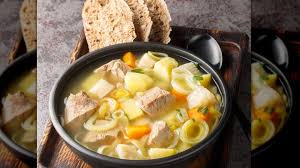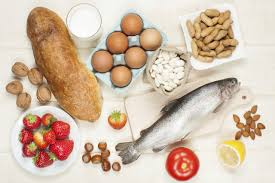When the weather turns cold and the Nordic chill sets in, nothing beats a warm bowl of soup to help you feel better. Soups are more than just meals in Scandinavia; they are traditions passed down through generations, crafted with locally sourced ingredients, and inspired by centuries-old culture. These soups demonstrate how basic and comforting Scandinavian cuisine is, with creamy salmon and hearty root vegetables.
In the following paragraphs, we’ll go over some of the most popular Scandinavian soups that do more than just fill you up. They also reflect the story of the region’s deep connection to the nature, history, and food.
Salmon soup from Finland
Lohikeitto, or creamy salmon soup, is one of Finland’s most famous dishes. It’s a simple yet delicious combination of salmon, potatoes, leeks, carrots, and cream, seasoned with dill and allspice. The end result is a velvety, nutritious bowl that feels like a warm embrace on a cold day.
This meal is commonly served in Finnish homes, and it may also be found at markets and ski lodges throughout the country.
Why this soup stands out:
- Richness that is balanced and not overly heavy
- Simple to make and easy to obtain supplies.
- A long-standing Finnish winter favorite
- Typically served with crispbread or rye bread.
Yellow pea soup from Sweden
Yellow pea soup, also known as ärtsoppa in Swedish, is a long-standing staple. It was traditionally served on Thursdays, followed by thin pancakes and jam for dessert. This remains a tradition in homes, schools, and even the military.
This soup is filling, substantial, and packed with protein. It is prepared with yellow split peas, pork (usually ham or bacon), onions, and marjoram or mustard. It’s especially popular in the winter, when a nutritious, one-pot meal looks appealing.
Key ingredients:
- Peas that are yellow
- Smoked ham or pork
- Mustard with onions
- Marjoram adds a pleasant aroma.
This soup demonstrates how much Swedes value tradition and practical cooking: it is simple, filling, and designed to feed a large number of people.
Danish kale soup
Grønkålssuppe, often known as Danish kale soup, is a delicious and nutritious dish. It comprises finely chopped kale, a cold-weather green rich in iron and vitamins. It is prepared with potatoes, leeks, and occasionally smoked meats or sausages.
People eat this soup a lot throughout the winter and holidays. It is typically served as an appetizer or light entrée.
What makes it special:
- Full of nutrients and fiber.
- Frequently consumed with Danish rye bread.
- A tasty winter soup with lots of greens.
- Smoked meat adds a rich, savory flavor to dishes.
Danish home food is simple, nutritious, and designed to warm you from the inside out. Kale soup is an excellent way to start.
Icelandic meat soup
Kjötsúpa is one of Iceland’s most popular foods. This soup combines soft lamb or mutton with root vegetables such as rutabaga, carrots, onions, and potatoes. It has a rich, meaty flavor because it was cooked gently and has been passed down through generations.
Families in rural areas frequently make large amounts of this soup and freeze the leftovers for future meals, especially during the winter when warmth and food are essential.
Highlights of kjötsúpa:
- Uses high-quality Icelandic lamb.
- Root vegetables provide an earthy flavor.
- Slow cooking produces the greatest flavor.
- Healthy and filling.
This soup is popular throughout Iceland, including Reykjavík and the countryside.
Norwegian fish soup
Fiskesuppe from Norway is a creamy shellfish soup with a variety of delicious flavors. White fish, such as cod or haddock, prawns, carrots, leeks, and potatoes are typically served in a mild cream sauce. Some variations add mussels or scallops to make it even richer.
This soup stands out because of its light, silky texture and fresh flavor. It is usually improved by adding herbs such as dill or chives. Served with flatbrød or thick sourdough, this dish is popular along the coast.
Popular pairings and features:
- Made with freshly caught fish.
- A light, creamy base.
- Fresh dill for flavor and aroma
- Perfect with Norwegian crispbread.
It strikes the ideal balance between tradition and innovation.
Creamy salmon soup revisited
The creamy salmon soup from Finland is not only popular, but it is also the ideal balance of richness and freshness. This Finnish version is lighter than other chowders, allowing you to eat it more frequently while still experiencing deep satisfaction.
Many Finnish families consider it their go-to comfort dish, particularly when it’s snowing or they’re in the sauna. The sweet vegetables and rich cream combine with the delicate salmon to create a dish that truly embodies the spirit of Finland.
Even if you’re unfamiliar with Nordic cuisine, this precise creamy salmon soup recipe will show you just how to create it. If you want to bring some Finnish warmth into your own kitchen, try it. It is ideal for those who are new to Scandinavian cooking and wish to try it at home.
Why soups are a staple in Nordic cuisine
Scandinavian soups are more than just seasonal flavors; they represent a way of life. Soups provided a practical and nutritious approach to meet the body’s needs throughout long winters with short days and a reliance on locally grown food. They also brought families together around the dinner table.
Common features of Nordic soups:
- Wild herbs and root vegetables.
- Fish and game meat from the area
- Simple ways passed down through the years
- Cooking with minimal waste and leftovers that are easily stored
These soups are intended to be powerful, soothing, and beneficial to the community—all of which are important to all Scandinavians.
Final thoughts
Scandinavian soups are more than just food; they demonstrate how people in the area have banded together, how powerful they are, and how they have traditionally done things. Every bowl of soup, whether it’s a rich Finnish salmon soup, a hearty Icelandic lamb broth, or a sweet Swedish pea blend, embodies the spirit of its home country.
If you want something warm and filling, try one of these traditional Nordic recipes. They will not only fill you up but will also provide a taste of the far north right in your own kitchen.
For More Information visit: dailypost & canberramagazine



